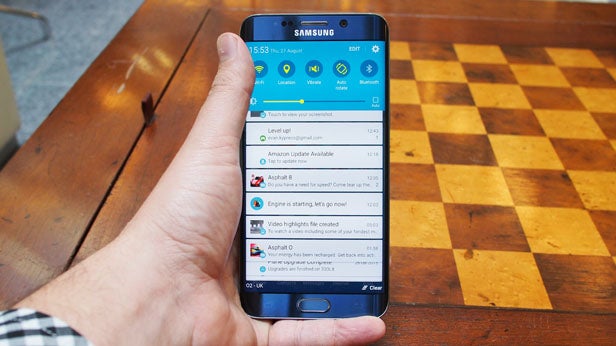


There's nothing comforting or natural about trying to hold onto something flat and angular and just a little bit slippery - that's something you may or may not get used to with time. I can't really say the Galaxy S6 is "comfortable" to use instead it feels a cold piece of technology in the hand. And that means the phone just isn't as grippy or easy to hold onto as the mostly-flat but plastic Galaxy S5, or a curved metal phone like the HTC One M9 (to say nothing of the latter's anti-slip coating), or the Moto X with its curved, leather (or wood or plastic)-covered back.
#ANDROID SOFTWARE FOR SAMSUNG GALAXY S6 CRACKED#
The Galaxy S6 hasn't cracked this particular problem - it's fairly large, flat and slick. A flat phone with barely-rounded edges just isn't the best shape to nestle into your hand comfortably, as anyone who's used a Nexus 4 or Xperia Z3 will quickly tell you. That's not some huge revelation, but it's something to consider when you look at a phone that is perfectly flat on the back. They're flexible and made up of rounded fingers of varying sizes. That's important, because this phone is a tad slick - the "glass and metal sandwich" design certainly looks nice, but it comes at a cost in terms of both ergonomics and durability. Rather than opting for perfectly round and slippery edge - like another well-known metal smartphone - flattened portions along the sides give a little extra grip. The metal frame is also masterfully done, as it flows straight through the middle of the phone in one piece, providing extra strength. Importantly, the same super-tough Gorilla Glass 4 is used on both sides, while some other manufacturers may cheap out on the back panel. Samsung has used a familiar "2.5D" technique for both the front and back glass so it flows elegantly into the metal frame. While we've all seen plenty of glass-backed phones before, that doesn't make this kind of design any less impressive when it's properly executed. But the shape was never the problem, it was all about the build quality and materials - and both have dramatically improved here. Of course the S6 still has the general shape of most other Samsung phones - rounded corners, home button below the screen, Samsung logo below a speaker grille up top. Metal, glass, appealing colors and tight tolerances add up to a very impressive piece of technology. Samsung has finally addressed these build quality criticisms in its 2015 flagship, and the result is something special - metal, glass, appealing colors and tight tolerances add up to a very impressive piece of technology. It's no secret that the Galaxy S5 - and many earlier models - felt like a child's toy, despite costing north of $600 unlocked. Say goodbye to cheap, flimsy plastic Samsung phones - the Galaxy S6 is here. Say goodbye to plastic - and a couple creature comforts Samsung Galaxy S6 Hardware Everything we say here can be attributed to both the S6 and S6 edge, aside from particular points where differences between the two models are pointed out.įor a good primer on these two phones, we also encourage you to read our in-depth hands-on preview where we cover many aspects of the Galaxy S6 and S6 edge in detail.

Throughout this review you'll notice we refer to the Galaxy S6 as a single device. For the majority of our review period we had a Moto 360 connected to the phones over Bluetooth.
#ANDROID SOFTWARE FOR SAMSUNG GALAXY S6 UPDATE#
Three days into our evaluation the phones received an software update to version UVU1AOCG. We're writing this review after about a week using the Galaxy S6 and S6 edge, both 32GB models and running on T-Mobile in areas with good network coverage. We'll answer that question in our complete review. But as we all know, the competition hasn't been sitting still - do the Galaxy S6 and S6 edge have what it takes to keep Samsung in the lead? The Galaxy S6 gets it one step closer to a complete rethinking of its device strategy, with a new hardware approach, top-notch camera experience and steps in the right direction on the software front. It became clear with the launch of the Galaxy Note 4 that Samsung was attempting to turn around its smartphone strategy - and that's a big ship to turn. Last year Samsung's complacency caught up with it, and while the Galaxy S5 was far from a flop - any company would be happy to sell half as many phones as Samsung did - it didn't exactly live up to the company's lofty expectations ( or ours, frankly), all while competition in the high-end space continued to grow. Watching the progression of Samsung's mobile device lineup the past couple of years, you got the feeling that the Korean manufacturer of everything from toaster ovens to Howitzers was content to maintain its course.


 0 kommentar(er)
0 kommentar(er)
